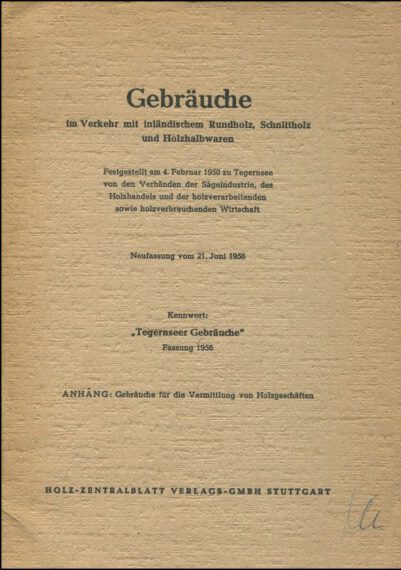The customs in the trade with wood and wood products in Germany are also known as theTegernsee Customs (TG for short) because the first compilation of timber trade customs was adopted at Tegern Lake in 1950 and subsequently revised in 1956, 1961 and 1985.
These Trade Customs have a kind of “norm character” owing to a link to Section 346 Commercial Code (Handelsgesetzbuch; HGB) and play a decisive role in the trade with wood and wood products in (legal) comparisons, claims and the conclusion of commercial transactions. They are not general terms and conditions of business that must be agreed.


Who is governed by the Customs?
The Customs govern activities between entrepreneurs, i.e. businesspeople (often called “B2B”). They apply even if they have not been explicitly agreed and even if one of the businesspeople involved does not know the Customs. The Customs do not apply solely if their governance has been expressly precluded in advance of the commercial transaction. Moreover, the Customs in the trade in timber and timber products do not apply solely to the timber trade, but to all those who trade in timber and timber products commercially and conclude transactions in these sectors. They also apply to commercial operators when acting as buyers — i.e. carpenters, joiners, builders, etc.
What is the significance of the Customs today?
The Customs are always important when no general terms and conditions of delivery and payment (GTD) or general terms and conditions of business (GTC) have been agreed between the business partners in timber trade transactions. While in most business transactions concluded today GTD are agreed, in the timber trade the GTD are oriented towards the provisions of the Tegernsee Customs.

What are the sticking points in the revision?
The general part of the Customs supplements and specifies concretely the provisions of the Commercial Code (HGB) and the law governing sales contracts found in the German Civil Code (Bürgerliches Gesetzbuch; BGB), which makes this part especially important. For example, Section 377 HGB (obligation to examine and give notice of defects) stipulates that goods must be examined without delay and, if necessary, a notice of defects must be submitted. The HGB does not specify what “without delay” means or the formal requirements for the notification of defects.
The Trade Customs make this HGB provision more precise by stating that “a claim must be submitted without delay, at the latest within 14 calendar days”. Furthermore, formal requirements for a proper notification of defects are stated. For instance, the notice of defects must be made in text form (NEW: email or other forms of text messages are permitted), without undue delay (at the latest within 14 calendar days) and include a precise description of the defects and the place of storage.
Other important points are general deadlines, which have been shortened since 1985 because of digital communication channels and means. Moreover, the product range of the timber trade has also changed considerably; while the trade in unedged logs tends to be the exception today, processed building products and building elements are the rule. The European and German regulations and standards are the primary governing factors here. Keywords are EU Construction Products Regulation, CE certification, grading according to trade rules or VOB.

Tegernsee Customs — this is an aid in the event of contention
and creates clarity
Procedure for the revision of the Customs of the timber trade
It is important to note that the precise definition of a Custom is only being revised and cannot be “changed”. Two methods were used to put the revision on a firm footing: a scientific survey of industry associations as part of a bachelor’s thesis and a detailed study of GTC and GTD of companies in the industry aimed at determining actual practise in daily work.
If a custom is now considered out of date, how does one determine the current custom? The first step in answering this was to analyse the sector’s GTC. For this purpose, each sub-section of the “TG” was compared with references from a total of 25 GTC from the industry that had been analysed, and the comments of the associations mentioned above were also considered. If comments by the associations now call for a revision and if, in addition, significant findings result from the comparison of the GTC, the need for a revision is clearly indicated. Ideally, both the associations’ comments and the GTC themselves will contain phrases and terms pointing the way to a new wording.

Adoption scheduled for 2022
EN – Nachdem die Neufeststellung des ersten Teils (Rechtliche Bestimmungen) der Handelsgebräuche abgeschlossen ist, laufen derzeit (Stand Mai 2021) Anpassungen des zweiten Teils (Produktspezifische Bestimmungen) und des Anhangs A der Güteklassen für Nadelschnittholz.
EN – Sobald ein abgestimmter Schlussentwurf verfügbar ist (Ende 2021/ Anfang 2022), können erneut Kommentare dazu eingereicht werden. EN – In einer abschließenden Kommissionstagung werden bestehenden Einwände final diskutiert und das abschließende Dokument verabschiedet. EN – Das Redaktionsteam rechnet mit einer finalen Veröffentlichung der neu festgestellten Handelsgebräuche Mitte 2022.
The entire industry should seize the opportunity to preserve these Customs and adapt them to meet the demands of the 21st century. A common language regime provides certainty and clarity in the drafting of contracts. It creates and maintains a degree of independence within the defined Customs vis-à-vis interpretations under contract law according to the German Civil Code (BGB) or the German Commercial Code (HGB) and in legal disputes.
Do not hesitate to contact us if you have any comments or questions.
Further information:
- Comparison (synopsis) of the newly revised Part 1 of the Customs (PDF, last revised Feb. 2021)
- EN – ENTWURF Teil 2 der Gebräuche als Gegenüberstellung (Synopse) (PDF, Stand Mai 2021)
- Tegernsee Customs as revised in 1985 (original scan/PDF)

